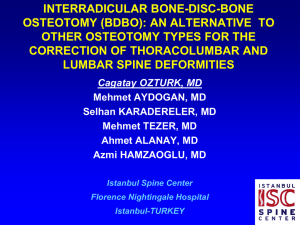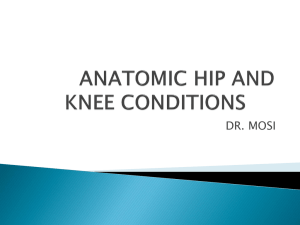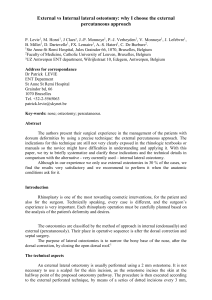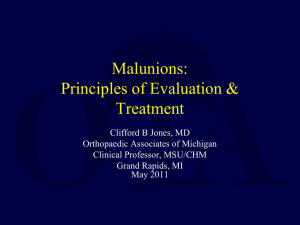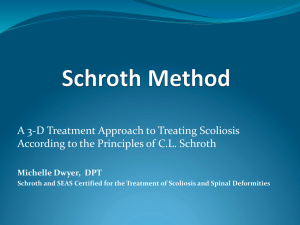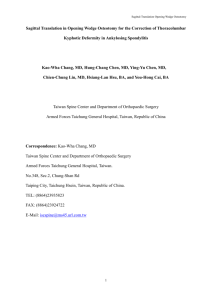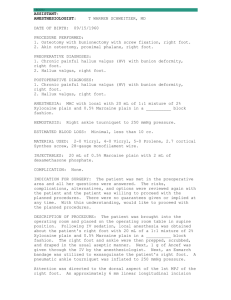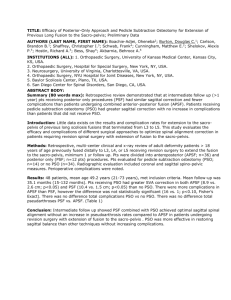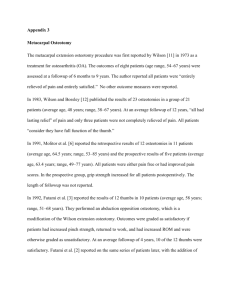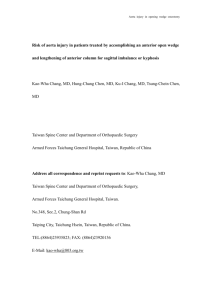abstract
advertisement
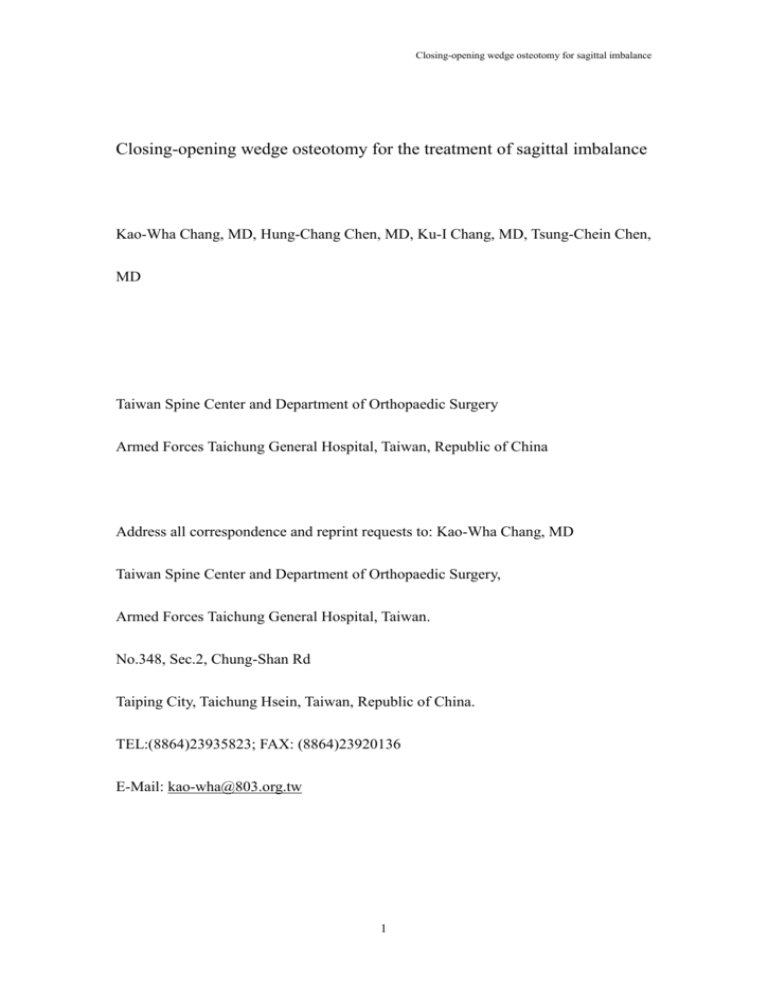
Closing-opening wedge osteotomy for sagittal imbalance Closing-opening wedge osteotomy for the treatment of sagittal imbalance Kao-Wha Chang, MD, Hung-Chang Chen, MD, Ku-I Chang, MD, Tsung-Chein Chen, MD Taiwan Spine Center and Department of Orthopaedic Surgery Armed Forces Taichung General Hospital, Taiwan, Republic of China Address all correspondence and reprint requests to: Kao-Wha Chang, MD Taiwan Spine Center and Department of Orthopaedic Surgery, Armed Forces Taichung General Hospital, Taiwan. No.348, Sec.2, Chung-Shan Rd Taiping City, Taichung Hsein, Taiwan, Republic of China. TEL:(8864)23935823; FAX: (8864)23920136 E-Mail: kao-wha@803.org.tw 1 Closing-opening wedge osteotomy for sagittal imbalance ABSTRACT Study Design: Prospective Objectives: Assess closing-opening wedge osteotomy (COWO) for sagittal imbalance requiring more than 35o lordotic correction at the level of osteotomy. Summary of Background Data: Correction of sagittal imbalance commonly utilizes pedicle subtraction osteotomy or closing wedge osteotomy (CWO). Anatomic limitation of one vertebral body restricts CWO to approximately 35o of lordosis at the osteotomized vertebra. Further movement often requires over one CWO to obtain adequate correction, but can also be achieved using closing-opening wedge osteotomy (COWO) at a single level by fracturing the anterior vertebral cortex. The efficacy of COWO for the treatment of sagittal imbalance is unclear. Methods: Eighty-three consecutive patients treated for sagittal imbalance with lumbar COWO at one institution with a minimum follow-up of two years were analyzed. Radiographic analysis included assessment of thoracic kyphosis, lumbar lordosis, lordosis through COWO site, and sagittal balance. Outcomes analysis utilized the Scoliosis Research Society questionnaire. Complications and radiographic findings were analyzed. Results: The average increases in lordosis and improved sagittal balance were 81.9o and 17.1 cm, respectively. Mean correction through the osteotomy site was 42.2o. No 2 Closing-opening wedge osteotomy for sagittal imbalance vascular injury occurred. While three patients developed lumbosacral pseudarthrosis, the COWO area was unaffected in all patients. Nine patients developed cephalad junctional kyphosis and two patients developed caudad junctional kyphosis, resulting in some loss of sagittal correction. Most patients reported improvement in terms of pain, self-image, and function as well as overall satisfaction with the procedure. Conclusions: COWO is a useful procedure for patients with sagittal imbalance requiring more than 35o lordotic correction through the osteotomy site. A worse clinical result is associated with increasing patient comorbidities, pseudarthrosis in lumbosacral fusion, and junctional kyphosis. Anterior column lengthening by COWO at a single level likely does not risk elongation of the vascular elements even with aortic athermatous calcification. Key words: closing-opening wedge osteotomy, closing wedge osteotomy, sagittal imbalance 3 Closing-opening wedge osteotomy for sagittal imbalance Key Points Closing-opening wedge osteotomy is highly effective in correcting sagittal imbalance requiring more than 35o lordotic correction at the osteotomized level. A worse clinical result is associated with cephalad and caudad junctional kyphosis, lumbosacral pseudoarthrosis, and increasing patient comorbidities. Aorta tolerance of lengthening at the level of osteotomy was exceptional, even with athromatous calcification. No vascular injury occurred. 4 Closing-opening wedge osteotomy for sagittal imbalance Mini Abstract Anatomic limitation of one vertebral body restricts closing wedge osteotomy to approximately 35o of lordosis at the osteotomized vertebra. Closing-opening wedge osteotomy (COWO) is a useful procedure for patients with sagittal imbalance requiring more than 35o lordotic correction through the osteotomy site. Anterior column lengthening by COWO at a single level likely does not risk elongation of the vascular elements even with aortic athermatous calcification. 5 Closing-opening wedge osteotomy for sagittal imbalance INTRODUCTION Symptomatic sagittal imbalance is prevalent in adult patients requiring spinal surgery1. Restoration of sagittal balance and pain reduction typically involves the Smith-Petersen, or open wedge, osteotomy (OWO) (Fig. 1), or the pedicle subtraction, or closing wedge, osteotomy (CWO) (Fig. 2). OWO-mediated lordosis involves shortening of the posterior column and lengthening of the anterior column, with the middle column comprising a pivot. Anterior column lengthening can produce vascular injury2,3,4. CWO (transpedicular wedge resection) permits correction through all three columns from a posterior approach without lengthening the anterior column, thereby maximizing the healing potential while avoiding stretch on the major vessels and viscera anterior to the spine, avoiding the risk of vascular injury. The anatomic limitation of the anterior cortex of one vertebral body restricts one-level CWO to approximately 35o and 25o of lordosis in the lumbar and thoracic spine, respectively5. When sagittal imbalance requires greater correction at the CWO site, fracture of the anterior cortex of the vertebral body is necessary, which transforms a CWO into a closing-opening wedge osteotomy (COWO) (Fig. 3). Little if anything is known of the use of COWO in patients with coronal, axial, 6 Closing-opening wedge osteotomy for sagittal imbalance and sagittal deformities. Presently, we assessed the complications and radiographic/functional outcomes of COWO in patients with sagittal imbalance. Additionally, we examined the feasibility of performing one COWO rather than several CWOs to accomplish large correction for severe sagittal imbalances and complex deformities. MATERIALS AND METHODS Medical records of 90 consecutive patients who underwent COWO for sagittal imbalance by the same surgeon from 2000–2004 were retrospectively reviewed. Two patients died of unrelated causes and five were lost to follow-up. The remaining 83 patients (52 women, 31 men, mean age of 66.1 years, range 52–76 years) were followed for 2–5 years. Diagnoses included flatback syndrome with instrumented lumbar fusion (n=14), degenerative kyphosis (n=26), posttraumatic kyphosis (n=13), iatrogenic kyphosis (n=11), and ankylosing spondylitis kyphosis (n=19). Patients with the apex of kyphosis in the cord territory were excluded, as they were treated with apical lordosating osteotomy6 to accomplish the large lordotic correction and prevent cord kinking. Preoperatively and at the time of the most recent follow-up, patients responded to 7 Closing-opening wedge osteotomy for sagittal imbalance the Scoliosis Research Society outcome questionnaire (SRS-24)7 regarding pain, self-image, function, and satisfaction. Intraoperative data included operative time and blood loss. Complications were also recorded. Long-cassette standing anteroposterior and lateral radiographs were made preoperatively, two months postoperatively, and at the most recent postoperative visit. The radiographs were analyzed to determine preoperative and postoperative fusion; osteotomy level; sagittal balance measured from the sagittal C7 plumb line to the posterosuperior corner of the S1 body; coronal balance measured from the coronal C7 plumb line to the center of the S1 body; sagittal Cobb angles between T5–T12 (thoracic kyphosis), T12–S1 (lumbar lordosis), between endplates of the osteotomized vertebra (COWO angle), and the Cobb angle of kyphotic deformity. Since the S1 body posterosuperior aspect was used as the sagittal balance reference point, the normal neutral range for this balance was considered to be 0–4 cm from this point (C7 plumb line running through the L5–S1 disc). Paired t tests were used for continuous variables between time-points. Statistical significance was set at p < 0.05. For surgery, each patient was positioned prone with padding at the iliac crests, knees, shoulders, and chest. The abdomen was free to reduce intraoperative bleeding. The osteotomy site was over the hinge in the table; as the osteotomy was closed, the 8 Closing-opening wedge osteotomy for sagittal imbalance table could be moved from the neutral to the V position. A standard posterior midline incision was made (usually from proximal level identified as the stable, neural, and horizontal vertebra with a stable superjacent disc in the coronal and sagittal planes to the sacrum). The spine was bilaterally exposed to the tip of the transverse processes with a strictly subperiosteal approach to reduce bleeding. Pedicle screws were inserted into several segments cephalad and caudad to the osteotomy level. Posterior decompression and lateral-recess decompression and foraminotomy of the involved stenotic levels were sometimes necessary to treat neurogenic claudication and pain. Laminectomy and facetectomy at the level of osteotomy were done. After both pedicles to be resected were identified, holes were made through them to the vertebral body, and curettes were used to enlarge the holes. The transverse processes were excised at their bases. With angle curettes, the cancellous bone was pushed anteriorly into the body to create a cavity. The anterior, posterior, and lateral cortexes of the body were thinned with angled curettes, and both pedicles were enucleated with a small osteotome. The posterior cortex was then pushed down into the body. A rongeur was used to resect the appropriate lateral cortex bilaterally. A prebent rod of appropriate lordosis was connected to the pedicle screws. The operating table was slowly moved to the V position to facilitate correction and provide 9 Closing-opening wedge osteotomy for sagittal imbalance space for lumbopelvic sagittal translation and rotation around the hip axis. The rod was rotated to correct any scoliosis and then pushed to compress the pedicle screws immediately above and below the osteotomy to correct kyphotic deformity and create the lumbosacral lordosis. The corrective procedures aimed for the best possible sagittal balance or alignment; restoration of the C7 sagittal plumb line falling within the L5-S1 disc for patients with global sagittal imbalance or sagittal alignment to normal for patients with regional sagittal imbalance (segmental hyperkyphosis). We initially preserved the anterior cortex of the body intact during closure of the osteotomy site. The anterior cortex at the level of COWO would be fractured at this position if correction attempted by closing the intravertebral osteotomy was insufficient and if the anatomic limitations were exceeded to approximate the best possible sagittal balance; this was especially the case if the bone was osteoporotic. Following case 30, the anterior cortex was weakened by bilateral penetration with a blunt-end trial to facilitate its fracture during corrective procedures for patients with sagittal imbalance requiring large magnitude of correction. We thus created a closing wedge of the posterior and middle columns and an opening wedge of the anterior column at the osteotomized vertebra. Central and lateral bone-on-bone contacts were tightly closed. The correction was fixed with another rod and fused with autogenous bone grafts. The roots and dura 10 Closing-opening wedge osteotomy for sagittal imbalance were checked to exclude residual compression by centrally enlarging the canal. A Woodson elevator was passed up and down the canal through the area of central decompression to detect dorsal neural compression created by osteotomy closure. Wake-up tests were done during surgery. The level of osteotomy was chosen on the basis of the location of the apex of kyphotic deformity. If there was no apex, such as flat back syndrome with instrumented lumbar fusion, preference was osteotomy caudad to the conus medullaris (below L1). If the site of osteotomy was in the territory of cord (above L1), two lordotic cages were inserted between the endplates of the osteotomized vertebra to maintain the height of middle column, which prevents cord kinking during corrective procedures5. The latter cases are not presently reported. COWO was performed at L2 in 58 patients and at L3 in 25 patients. The arthrodesis was stopped at L5 in 26 patients in whom the L5–S1 disc appeared well preserved or was completely collapsed and stable. The arthrodesis was extended to S1 in the remaining patients. Iliac screws were used for all arthrodeses to the sacrum. Anterior bone grafts were not routinely used for segments added to the arthrodesis. However, interbody fusion with posteriorly placed wedge-shaped cages for anterior-column support and fusion at L5–S1 were performed along with neurological decompression procedures for 21 patients combined with spinal stenosis 11 Closing-opening wedge osteotomy for sagittal imbalance at L5–S1 because of the known difficulty of obtaining a long fusion to the sacrum. Patients ambulated 48 hours later and used custom-made thoracolumbar orthoses for at least 6 months postoperatively. RESULTS Surgical outcomes The mean estimated blood loss and operating time were 3340 mL (range 2519–7160 mL) and 245 minutes (range 191–313 minutes), respectively. No perioperative deaths or vascular complications occurred. Three patients who developed postoperative pneumonia were successfully treated. One patient experienced acute cauda equina syndrome immediately postoperatively. A computerized tomography myelogram showed a block at the level of osteotomy due to blood clot compression. Evacuation the blood clot was performed the same day; neurological recovery was complete. Two patients developed congestive heart failure, which resolved after medical management. One patient developed a superficial wound infection that was successfully debrided, closed, and treated with antibiotics. Fifteen patients developed paralytic ileus, which resolved after a Levin tube was inserted and oral intake restricted. Dural tear in three patients was repaired during surgery. Two patients complained of prominence of the iliac screws, which were subsequently removed. L5–S1 rod breakage with 12 Closing-opening wedge osteotomy for sagittal imbalance pseudarthrosis-mediated kyphosis that occurred in three patients was treated with anterior and posterior bone grafts. Nine of 83 patients developed progressive junctional kyphosis at the cephalad end of the construct. Three patients developed late compression fracture of the most cephalad vertebral body included in the construct, and another three patients developed a compression fracture immediately above the instrumented level; all resulted in kyphosis and loss of sagittal balance and required extension to the upper thoracic spine. Three patients did not have radiographic evidence of any compression fracture but became progressive kyphotic and required extension to the upper thoracic spine. Two patients with a long fusion to L5 developed caudad migration of the distal screw with some loss of sagittal correction. Revision surgery and improved sagittal balance were achieved using CWO and extension of the instrumentation to the sacrum (Table 1). Radiographic results Mean sagittal balance improved from 18.2 ± 8.9 cm preoperatively to 1.1±3.3 cm two months postoperatively (p < 0.01). At the final postoperative visit, the mean sagittal balance increased to 4.7 ± 3.1 cm (p = 0.04 compared with the two month postoperative value). Loss of correction due to distal migration of the L5 pedicle screw was seen in two patients who had a fusion to L5. Loss of correction was also observed in nine patients who had development of a cephalad junctional kyphosis. 13 Closing-opening wedge osteotomy for sagittal imbalance Substantial loss of correction also occurred in three patients who developed lumbosacral pseudarthrosis. Sagittal correction in the remaining 69 patients was maintained and there were no significant differences in the values between the two-month and most recent postoperative visits. The mean correction through the osteotomy site was 42.2o (range, 31–55 o) two-months postoperatively and 41 o at the most recent follow-up. All the opening wedge gaps created in the anterior column obtained fusion (Table 2 and Fig 4). Questionnaire results Eighty of the 83 patients completed the SRS-24 questionnaire preoperatively and at final follow-up (Table 3). With a higher score being indicative of a better result, the total and subset scores were: total score (120), postoperative score (final 9 questions 45), pain (25), self-image (25), and function (25). Domain scores were significantly improved for pain (p < 0.01), self-image (p < 0.01), and function (p = 0.03). On the basis of the last nine questionnaires, reported detrimental aspects of spine treatment included reduced function and daily activity (n=15), reduced ability to participate in sports and hobbies (n=19), and increased back pain (n=8). Of the latter eight patients, the pain was due to implant failure and pseudarthrosis at L5–S1 (n=2), caudad junctional kyphosis (n=2), cephalad junctional kyphosis (n=3), and metastatic prostate cancer (n=1). In contrast, 71 patients believed that the spine treatment had improved 14 Closing-opening wedge osteotomy for sagittal imbalance their confidence and personal relationships with others. Reported benefits included improved perception by others (n=70), better self-image (n=67), and improved personal appearance (n=75). The overall satisfaction scores (questions 22 and 24) were high. Seventy-two of the 80 patients were "satisfied" with the treatment, six were ambivalent, one was somewhat dissatisfied, and one was extremely dissatisfied. Seventy-one of the 80 patients would have the treatment again, seven were not sure, one probably would not, and one definitely would not. The two patients who were dissatisfied with the treatment would also not seek treatment again. One developed postoperative congestive heart failure and the other developed metastatic prostate cancer. DISCUSSION The present study analyzed the clinical and radiographic results for patients undergoing COWO for complex deformities. To our knowledge, the present study represents the largest series of patients with multiplanar deformity who have been managed with COWO. Patients with sagittal imbalance cannot stand erect without compensatory hip extension, knee flexion, and overwork of the erector spinal musculature because reduced moment arm compromises the mechanical advantage. The result is muscle 15 Closing-opening wedge osteotomy for sagittal imbalance fatigue and activity-related pain. As patients age, muscular weakness, adjacent disc degeneration, and hip and pelvic disease may decrease compensation and increase disability. Restoration of normal and economical sagittal balance reduces the work of the spinae erecta and hamstring muscles to achieve balance during normal activity. The spine should be fused in a balanced position that is as close to the normal configuration as possible because insufficient deformity correction involving posterior instrumentation alone may lead to lost correction, pseudarthrosis, increased reoperation rates, or poor clinical results8,9. CWO can provide acceptable clinical and radiographic results for patients with sagittal imbalance9. However, anatomic limitation of a vertebral body restricts CWO to about 35° lordosis5,11,12. When sagittal imbalance exceeds 25 cm, consideration should be given to performing more than just one CWO to obtain adequate correction10, increasing the risks and complications of the surgery. In our present and previous13 studies, higher correction was achieved with COWO by fracturing the anterior vertebral cortex. This avoids the necessity for another osteotomy at another site. The prevalence of satisfactory results highlights the utility of COWO to surgically treat sagittal imbalances that require large correction. The technique is a three-column release that makes a rigid deformity flexible enough to be adequately manipulated from behind to obtain optimal correction. 16 Closing-opening wedge osteotomy for sagittal imbalance COWO shortens the posterior and middle spinal columns. Many believe excessive shortening is dangerous; limiting corrections to approximately 30–40° has been recommended12. If kyphotic correction exceeds 40° with spine shortening, the spinal cord may be too long for the shortened column, resulting in curving, kinking, or damage14. Correction at any level for posterior transvertebral osteotomy should not exceed approximately 35°11. For transpedicular wedge resection osteotomy, correction of a sagittal deformity should be below L1 and of a magnitude correctable with a closing wedge <45°15. Many patients in our current and previous13 studies achieved correction of over 45 o without neurologic complications, demonstrating the safety of closing wedge below L1 as well as the tolerance of cauda equina. Redundant cauda equina may not be problematic if enough bone is removed to accommodate the excess neural tissue. It is generally believed that in elderly patients anterior column lengthening at a single level by OWO carries a risk of elongating the tethered aorta or calcific nondistensible aorta, which could prove disastrous. However, no aorta injury occurred in this study. Aorta injury has been reported if the opening wedge is performed at L1–2 or L2–32,3,4. Reviewing these reports and postmortem findings reveals two cases of rheumatoid spondylitis treated preoperatively with X-ray therapy, in which adherence between the aorta and the underlying anterior longitudinal ligament 17 Closing-opening wedge osteotomy for sagittal imbalance resulted in a complete transverse tear in the posterior wall of the aorta after manual osteoclasis and non-surgical or surgical correction2,3. Such preoperative therapy was not conducted presently. We did not find any reference in the literature that the presently-observed etiologies are linked to aortic-longitudinal ligament adherence. In the other two cases involving ankylosing spondylitis kyphotic patients with athromatous calcification of their abdominal aorta4, the vascular injuries involved OWO-related aortic wall tear and dissection of media. Stretching of calcific nondistensible aorta that created internal and media tears may have led to rupture and aneurysms. However, based on our observations of the absence of aortic injury in 354 patients treated with OWO including 101 patients with athromatous calcification of abdominal aorta, apical lordosation osteotomy6, or COWO for correction of sagittal imbalance or kyphosis via an anterior open wedge and lengthening of the anterior column, the aorta can likely tolerate stretch and lengthening very well, even when complicated by athermatous calcification16. Aorta lengthening was measured at the level of osteotomy in 49 patients who displayed roentgenographically-obvious athermatous calcification marks exactly opposite the site of osteotomy in the aorta, by comparison of the pre- and postoperative lengths between the same athromatous calcification marks. The mean aorta lengthening at the level of osteotomy was 2.8 cm (range, 1.7-3.5cm)16 (Fig 4D). 18 Closing-opening wedge osteotomy for sagittal imbalance Presently, we observed that paralytic ileus increased with COWO, perhaps in association with elongation of the lumbar anterior column, caused tension on the anterior abdominal organs. All cases resolved with gastric-tube decompression. One of the concepts behind the COWO procedure is that surgery on all three columns is performed through a posterior approach and a gap is created in the anterior column. Our observations indicate that anterior grafting is not required. All the anterior open wedges obtained solid fusion. Osteoclasis and rigid fixation may mimic a close fracture with rigid fixation, which always produces solid union of a fracture. No substantial loss of correction through the site of COWO was apparent. Presently, cephalad junctional kyphosis (n=9) and caudad junctional kyphosis (n=2) resulted in significant loss of sagittal balance. All required reoperation for progressive junctional kyphosis, which may be an inevitable consequence of multilevel instrumentation in patients with poor bone stock17. A potential approach to this problem is to perform limited fusion with the intention of staging proximal extension as the junctional kyphosis progresses. Increased motion and stress concentration at this junctional area can induce instrumentation failure and adjacent segment problems, leading to junctional kyphosis. There may be other reasons why the present incidence of junctional kyphosis was so high. A group of patients 19 Closing-opening wedge osteotomy for sagittal imbalance presented with lumbar kyphosis and many had substantial positive sagittal balance. Given the long-standing nature of their deformities, these patients might have equilibrated to a more forward-flexed position and, therefore, continued to stand in this familiar, stooped posture, despite the local change in lumbosacral lordosis achieved during the instrumented reconstruction. This would suggest a role for some, as yet unidentified neurologic or proprioceptive mechanism that contributes to an individual’s ability to maintain a neural sagittal balance. Undoubtedly, the severe reconditioning of the lumbar paraspinal musculature that occurred as the result of the posterior exposure influenced the patients’ ability to stand erect. Three-rod breakage with subsequent kyphosis occurred at L5–S1 in some patients in the absence of pullout or breakage of S1 screws. For long fusions to the sacrum, a montage of bilateral S1 and iliac screws effectively protected the sacral screws. Nonetheless, pseudarthrosis occurred at L5–S1, which unexpectedly manifested as rod breakage on both sides. Anterior-column support and anterior bone grafting reduced but did not eliminate the complication. So, it was not our routine practice to perform structural grafting at L5–S1 through the anterior approach. We used high concentrations of autogenous bone anteriorly and posteriorly to treat pseudoarthrosis after its occurrence. In conclusion, we believe that COWO can provide acceptable clinical and radiographic results for patients who have had sagittal imbalance requiring a large 20 Closing-opening wedge osteotomy for sagittal imbalance magnitude of correction. The operative times in the present study were reasonable, but some patients lost a substantial amount of blood. Complications were seen in approximately 49% of the patients. Pseudarthrosis and loss of correction at the level of COWO was not observed. However, lumbosacral pseudarthrosis and junctional kyphosis were problematic. Although anterior column lengthening at the osteotomized level by COWO elongated the stiff aorta in elderly patients, the aorta seemed to tolerate the lengthening very well and no vascular injury occurred. The level of patient satisfaction was high after more than two years of follow-up, with most patients having improved resolution of pain, increased self-image, and greater function. A worse clinical result was associated with junctional kyphosis, lumbosacral pseudoarthrosis, and increasing patient comorbidities. REFERENCES 21 Closing-opening wedge osteotomy for sagittal imbalance 1. Booth KC, Bridwell KH, Lenke LG, et al. Complications and predictive factors for the successful treatment of flatback deformity (fixed sagittal imbalance). Spine 1999;24:1712-20. 2. Lichtblau PO, Wilson PD. Possible mechanism of aorta rupture in orthopaedic correction of rheumatoid spondylitis. J Bone Joint Surg Am 1956;38:123-7. 3. Klems VH, Friedebold G. Ruptur der Aorta abdominalis nach Aufrichtungsoperation bei Spondylitis ankylopoetica. Z Orthop 1971;108:554-63. 4. Weatherly C, Jaffary D, Terry A. Vascular complications associated with osteotomy in ankylosing spondylitis: a report of two cases. Spine 1988;13:43-6. 5. Bridwell KH. Decision making regarding Smith-Petersen vs. pedicle subtraction osteotomy vs. vertebral column resection for spinal deformity. Spine 2006;31:S171-8. 6. Chang KW, Chen YY, Lin CC, et al. Apical lordosating osteotomy and minimal segment fixation for the treatment of thoracic or thoracolumbar osteoporotic kyphosis. Spine 2005;30:1674–81. 7. Haher TR, Gorup JM, Shin TM, et al. Results of the Scoliosis Research Society instrument for evaluation of surgical outcome in adolescent idiopathic scoliosis. A multicenter study of 244 patients. Spine 1999;24:1435-40. 8. Grubb SA, Lipscomb HJ. Diagnostic findings in painful adult scoliosis. Spine 1992;17:518–27. 22 Closing-opening wedge osteotomy for sagittal imbalance 9. Bradford DS, Tay BK, Hu SS. Adult scoliosis: surgical indications, operative management, complications, and outcomes. Spine 1999;24:2617–29. 10. Bridwell KH, Lewis SJ, Lenke LG, et al. Pedicle subtraction osteotomy for the treatment of fixed sagittal imbalance. J Bone Joint Surg 2003;85-A:454-63. 11. Lehmer SM, Keppler L, Buscup RS, et al. Posterior transvertebral osteotomy for adult thoracolumbar kyphosis. Spine 1994;19:2060–7. 12. Gertzbein SD, Harris MB. Wedge osteotomy for the correction of posttraumatic kyphosis. Spine 1992;17:374–9. 13. Chang KW, Chen YY, Lin CC, et al. Closing wedge osteotomy versus opening wedge osteotomy in ankylosing spondylitis with thoracolumbar kyphotic deformity. Spine 2005;30:1584–93. 14. Kawaharu H, Tomita K. Influence of acute shortening on the spinal cord: an experimental study. Spine 2005:30;613-20. 15. Berven SH, Deviren V, Smith JA, et al. Management of fixed sagittal plane deformities. Spine 2001;26:2036–43. 16. Chang KW, Chen YY, Lin CC, et al. Risk of aorta injury in patients treated by accomplishing an anterior open wedge and lengthening of anterior column for sagittal imbalance or kyphosis. Spine 2007, submitted. 17. Dewald CJ, Stanley T. Instrumentation-related complications of multilevel fusion 23 Closing-opening wedge osteotomy for sagittal imbalance for adult spinal deformity patients over age 65. Spine 2006;31:S144-51. Figure Legends 24 Closing-opening wedge osteotomy for sagittal imbalance Figure 1. Diagrams of OWO. A, Lateral view outlining the bone block to be resected. Total pediculectomy avoids nerve root compression by the remaining pedicle because of sagittal rotation of the cranial vertebral column in OWO17. B, Postoperative lateral view showing that correction is achieved by hinging on the posterior border of vertebral body, closing the posterior osteotomy, and creating an open wedge of the anterior column. Figure 2. Diagram of CWO. A, Lateral view outlining the bone block to be resected. B, Postoperative lateral view showing that correction is achieved by hinging on the anterior cortex of the vertebral body and closing the intravertebral osteotomy. Figure 3. Diagram of COWO. A, Lateral view outlining the bone block to be resected. B, Postoperative view showing the correction is achieved by hinging on the closed middle column, closing the intravertebral osteotomy, and creating an open wedge of the anterior column. Figure 4. A representative example. A, Sixty-seven--year-old woman with iatrogenic kyphosis (kyphosis after laminectomy). A, Presurgical image showing 75o kyphosis, 15 cm sagittal balance, and 61o T12–S1 lordosis. B, Final values were -30o kyphosis, 3 cm sagittal balance, and -55o T12–S1 lordosis. The patient was pain free and extremely satisfied with the outcome. C, The correction through the osteotomy site was 40o. The anterior open wedge obtained solid fusion. D, The magnitude of aorta lengthening at the level of osteotomy was 2.4 cm, as determined by measuring the difference in the length between the same athermatous calcification marks exactly 25 Closing-opening wedge osteotomy for sagittal imbalance in front of the osteotomized vertebra seen roentgenographically in the aorta before and after operation. The aorta tolerated the lengthening very well. E, Preoperative and ultimate appearances. 26 Closing-opening wedge osteotomy for sagittal imbalance Table 1. Summary of complications Complications Perioperative death No. of patients (N = 41) 0 Acute cauda equina syndrome 1 Wound infection 1 Congestive heart failure 2 Dura tear 3 Pneumonia 3 Paralytic ileus 15 Prominence of lilac screw 2 Cephalad junctional kyphosis 9 Caudad junctional kyphosis 2 Implant failure / pseudoarthrosis 3 27 Closing-opening wedge osteotomy for sagittal imbalance Table 2 Radiographic Data Summary Measurement Preoperative Postoperative 2 months Last Follow-Up Correction Loss of correction T1–T12 kyphosis (°) 25.9 ± 11.1 29.2 ± 16.8 31.8 ± 16.3 3.3 ± 3.1 3.5 ± 2.5 T12–S1 lordosis (°) 9.2 ± 3.2 -54.8 ± 16.8 -51.3 ± 17.1 64 ± 21.4† 3.5 ± 3.3 Kyphosis (°) 66.5 ± 17.4 -15.4 ± 4.7 -13.7 ± 4.5 81.9 ± 21.5† 1.7 ± 2.1 Sagittal balance (cm) 18.2 ± 8.9 1.1 ± 3.3 4.7 ± 3.1 17.1 ± 7.8† 3.6 ± 3.3† Coronal balance (cm) 4.1 ± 1.1 1.5 ± 1.7 1.3 ± 1.1 2.6 ± 1.3† 0.2 ± 1.3 COWO angle (°) 12.1 ± 7.2 -30.1 ± 13.2 -28.9 ± 14.1 42.2 ± 19.1† 1.2 ± 1.9 Data are mean ± standard deviation. †P < 0.05 COWO = closing-opening wedge osteotomy 28 Closing-opening wedge osteotomy for sagittal imbalance Table 3 SRS outcome instrument paired scores (N = 80) Mean at preoperative Last 9 scores (45 possible) SRS domain Pain (25 possible) 10.5 ± 3.5 Self-image (25 possible) 11.3 ± 4.7 Function (25 possible) 12.4 ± 5.41 Values are expressed as mean ± SD P (preoperative to final follow-up) Mean at final follow-up 38.2 ± 8.1 20.8 ± 6.1 22.3 ± 6.3 17.3 ± 5.0 < 0.01 < 0.01 0.03 29 Closing-opening wedge osteotomy for sagittal imbalance 30 Closing-opening wedge osteotomy for sagittal imbalance 31 Closing-opening wedge osteotomy for sagittal imbalance 32 Closing-opening wedge osteotomy for sagittal imbalance 33 Closing-opening wedge osteotomy for sagittal imbalance 34 Closing-opening wedge osteotomy for sagittal imbalance 35 Closing-opening wedge osteotomy for sagittal imbalance 36 Closing-opening wedge osteotomy for sagittal imbalance 37
